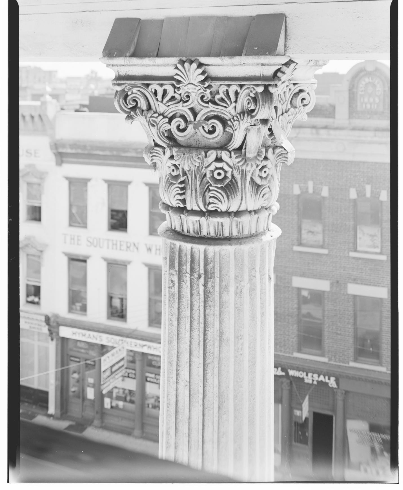THE CHARLESTON HOTEL
We visit the site of the Charleston Hotel on our Lost Charleston Tour and our Charleston Overview Tour.
Renowned for its opulence and grace, the Charleston Hotel was an iconic symbol of the city’s antebellum glory: “one of the few remaining links with the romantic days of terrapin soup, gas lights and visiting royalty,” according to columnist Ashley Cooper (nom de plume for News & Courier editor Frank B. Gilbreth Jr., March 3, 1986).
Designed by architect Charles F. Reichardt, the hotel at 200 Meeting Street was built on a lot that had been left vacant following an 1835 fire. Its fine interior detailing was still being completed when this second structure likewise was destroyed in the Great Fire of 1838. Rebuilt per Reichardt’s design, it finally opened in 1839.
“Traveling men usually remember the places they visit by the kinds of hotels at which they stopped,” wrote a News and Courier reporter on Jan. 1, 1910. “In Charleston there is one hotel that the consensus of opinion has named ‘The Best.’ This is the Charleston Hotel … a part of [the city’s] traditions.”
It was a grand structure. A block-long colonnade of 14 pillars with Tower of the Winds capitals distinguished its four-story Parthenon-style façade. It featured 170 bedrooms (singles and suites), bathrooms, two large and elaborately decorated dining rooms, parlors, reading and reception rooms, and a gentlemen’s shaving saloon. Over time, its amenities included having its own electric plant, hot and cold running water, elevators, telegraph office, in-house doctor and pharmacist, dairy (with an electric milker!), poultry farm for fresh eggs, cold storage, on-site bakery, washing machines that could sterilize glassware and china, a steam laundry, and automobile service.
Needless to say, such luxury, style and class appealed to upscale visitors, among them Oscar Wilde, Daniel Webster, international soprano star Jenny Lind, England’s Princess Louise, and three U.S. Presidents: Theodore Roosevelt, Calvin Coolidge and William Howard Taft. The hotel hosted meetings of the revered South Carolina Jockey Club, along with innumerable balls, banquets and other social affairs.
The Civil War changed the hotel, however, as it did all aspects of life in Charleston. By the 1890s, the Charleston Hotel was taking in local boarders at cut-rate rents. S.C. Gov. Ben Tillman, in 1893, cracked down on the establishment for illegally selling alcohol after passage of his Distillery Act. Much of the hotel stood vacant, signaling a long decline through the first half of the 20th century. Unable to keep pace with modern upgrades, the grande dame of Charleston hotels was slated for demolition in 1959.
She didn’t go down without a fight, though. Demolition took nearly six months, a process so protracted that to stay on schedule, the new motel that would replace its grand predecessor was being built even before demolition of the old hotel was complete. When steel cables and bulldozers failed to pull down its Corinthian colonnade, demolition teams brought in a 2,000-pound wrecking ball. The last column came down in a haze of dust and rubble shortly after 3 a.m., according to an April 30, 1960, newspaper account. Destruction of the Charleston Hotel prompted preservationists to successfully push to expand the city’s protected historic district beyond the South of Broad neighborhood.
About 150,000 of the nearly 1 million Charleston-made bricks that were salvaged from the old hotel were used to build the new one-story Heart of Charleston motor lodge on the site. In 1989, the motel was demolished for a bank.

MEMORIES
Ira Berendt responded to the Do You Know Your Charleston column, saying:
"My dad, Harry Berendt, and his brothers owned I. Berendt Leather Co. across the street from the Charleston Hotel...I recall getting haircuts as a boy in the lobby of the old hotel. The pungent aroma of shaving cream mingled with cigar smoke was ever-present. Spitoons lined the floor, the snap of wide leather belts as the barbers sharpened their razors, reading my first Playboy magazine. Lotsa memories! There was a rumor that one of the barbers, angry with a customer, slit his throat and he died in the chair."
Beau Booker shared the following:
[Helen Sottile], a daughter of Santo, and thus with her siblings an owner of the Heart of Charleston ... where she'd actually lived as a C of C student. Summertime, she'd take us down to swim - "Don't bother the tourists," who were few and far between - while she and her sisters and cousins would enjoy Happy Hour(s) up on the raised deck as basically their private bar, jabbering away in Palerman Sicilian."




